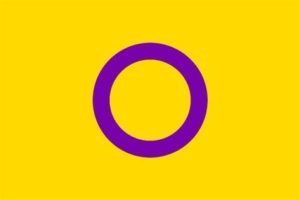Writing Intersex Characters
Welcome back to Queering the Narrative! This week, we’re focusing on the I in the extended LGBTQIA+ acronym to talk about writing intersex characters.
What is Intersex?
Before writing intersex characters, you of course have to know just what intersex actually means. And, when you dig into it, the term gets really complex really quickly.
Generally, the term “intersex” is an “umbrella term for differences in sex traits or reproductive anatomy.” These traits are present in about 1.7% of the human population -- a higher percentage than identical twins (0.3%) and comparable with the percentage of folx with red hair (~2%). Roughly 1 in 2000 births will have visible genital variations that a doctor might suggest surgical intervention for.
Most notably, intersex advocacy groups like InterACT stress that intersex traits are not inherently disorderded -- rather, they are natural variations in the presentation of human sex characteristics. Some intersex traits might require medical interventions, such as if an infant doesn’t have a urethral opening (which is very rare) or has a hormone imbalance that can lead to harmful metabolic complications. Almost all intersex folx, however, lead perfectly healthy lives with their intersex traits, whether or not they receive so-called “corrective” surgery as an infant.
In fact, those surgeries are the core of intersex advocacy. When a child is born with ambiguous genitalia or gonads, physicians often advocate that a parent make a decision on the baby’s gender and then perform surgery on the newborn in order to “correct” their anatomy. The nominal goal here is to grant the children a “normal” life -- but these surgeries more often result in lifelong emotional and physical trauma, high risks of complications, and reduced sexual function later in life. And all of that for aesthetics and the comfort of parents and physicians, often before a child is 2 years old, and entirely without the intersex individual’s consent. Despite the UN considering these surgeries human rights violations, they are still widely practiced and there are few laws on the books (especially in the US) prohibiting them.
Because the shape of the genitals and the presence of certain gonads are almost never emergency concerns, the course of action that intersex advocacy groups recommend is always to wait and allow the intersex individual themself to make the decision about their own body when they are old enough to understand and give proper consent.
Are Intersex People Queer?
Not inherently.
An intersex person can have any sexual or romantic orientation that a dyadic (non-intersex) person can. Some may see their intersex traits as setting them outside the gender binary, or might identify with a trans identity because they don’t identify with the gender they were assigned at birth (whether or not an intersex surgery was performed on them). Others, however, do identify with their assigned gender and are attracted to the “opposite” gender -- and therefore consider themselves cis and straight.
The Ken and Amy storyline on Freaks and Geeks involved a gay panic based largely on this sort of assumption.
Intersex itself is not a queer identity -- but there’s a lot of overlap between the struggles faced by queer folx and those faced by intersex folx, which is why there’s an I in the extended LGBTQ+ acronym. The shame and pathologization of an intersex person’s “ambiguity” is rooted in the same patriarchal, racist, and eugenic ideals that first defined the rigid delineation of the sexes and continues to drive fear and hate toward gay, bi, and trans folx. These fears motivate the push for conformity and the idea that children are “better off” with standard-appearing genitals. This overlap motivates a strong coalition between intersex and LGBT+ advocacy, in order to further the goals of both social groups and especially to acknowledge the intersections between them
However, you shouldn’t mark an intersex person as inherently queer. Queer is entirely a self-applied identity, and it’s gross to slap it on someone else without knowing how they internally identify -- especially if you’re doing so based entirely on their personal medical history.
What’s it like to be intersex?
Intersex people continue to face erasure, marginalization, and pathologizing with historic and contemporary similarities to queer folx, especially trans and nonbinary people.
Many people still refer to intersex traits as “disorders of sexual development,” or DSDs, despite the fact that individuals can grow up perfectly healthy with these traits. This positions them and their bodies as aberrant or wrong, motivating the societal shame and forcing them into hiding, as well as deeming the horrific surgeries performed on them as acceptable. For folx who don’t undergo puberty, or who develop visibly mixed “male” and “female” traits during puberty, the visibility of their intersex traits can lead to ostracization by their peers.
When writing intersex characters, it’s important to consider these challenges. Many people consider their intersex traits to be private medical history. Some others will embrace and advocate for their “nonbinary bodies.” No matter what, however, intersex folx are likely to face discrimination and may find comfort, solace, or pride in peer groups or advocacy networks that strive to normalize their experiences (similar to how queer folx tend to seek out queer spaces).
Writing Intersex Characters
You really, really gotta do your research here
There are so, so many ways that someone can be intersex. This InterACT page includes a table listing some common intersex traits. Wikipedia lists even more possibilities.
When writing intersex characters, make sure that you understand the specifics of their intersex traits. However, if you don’t have an intersex trait, it’s probably best not to belabor the point or get into the nitty-gritty details. This research is more to know what not to do -- you can’t, for example, claim a character has Klinefelter’s syndrome but then say they’ve got “both sets” of genitals. In fact, I’ll dip a toe into Tropes to Avoid territory and go ahead and say DON’T FOCUS ON GENITALS AT ALL.
More relevant, perhaps, is if you were going to state or imply that someone has health complications -- like increased risk of cancer -- which actually don’t come along with their intersex traits. Do your research!
Writing intersex characters also requires that you understand that intersex people aren’t a monolith. Their experiences with society and the medical community may unite them in advocacy, and they may work alongside or identify with the queer community, but you can’t make any broad sweeping statements about intersex people (just like you can’t make broad, sweeping statements about dyadic queer folx.) Don’t just define your character by their intersex traits!
Conclusion
Respect and knowledge are, as always, the key to successfully writing intersex characters. Make sure that you get your information from advocacy groups such as InterACT or the Accord Alliance.

